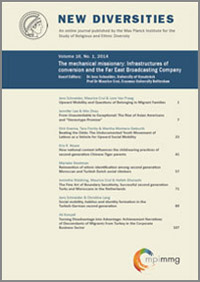Religious Diversity in Italy and the Impact on Education: The History of a Failure
by Maria Chiara Giorda (Università di Milano – Bicocca)
To cite this article: Giorda, M. C. (2015). Religious Diversity in Italy and the Impact on Education: The History of a Failure. New Diversities, 17(1), 77–93. https://doi.org/10.58002/yewp-3790
Cultural diversity and plural religiosity characterize today’s Italy. These characterizations are traits of contemporary migration flows, which have put the country among the top receiving destinations in all of Europe since the 2000s. While diversity and religious pluralism have become politically salient issues in current public debate, these traits have contributed to forging the Italian national identity for centuries.
The different relationships entangling Italy’s political and cultural institutions and the education system traditionally regard the search for a common path that conciliates religion, religious diversity and secularism as a confrontational and divisive field of action. Actors who are involved in this field, from teachers to NGOs and the Italian Ministry of Education, work to find strategies to adjust the needs emerging from relatively new religious environments.
An increasing share of students coming from a diverse population and religiosity are disrupting the long-established cohabitation of the Catholic Church and the State in the public sphere.
This article tries to present different models about thinking, teaching and dealing with religions in Italy in the last 20 years, highlighting the opportunities, limitations and weaknesses associated with these attempts. If the resources of knowledge and the development of teaching skills available in schools are important for the processes of social integration, then the legislative framework, the decisions, and the services of political institutions are pivotal for the monitoring and management religious pluralism. By and large, the public school system is still tailored in prevalence to Catholic religion, festivals, customs, and precepts. Three focuses (religious education, school canteens and the case of crucifix) help to show how non-secular practices and politics have missed, until now, the opportunity to deal with pluralism.
Keywords: Religious diversity, public places, secularism, education about religions, school canteens, religious symbols
|
